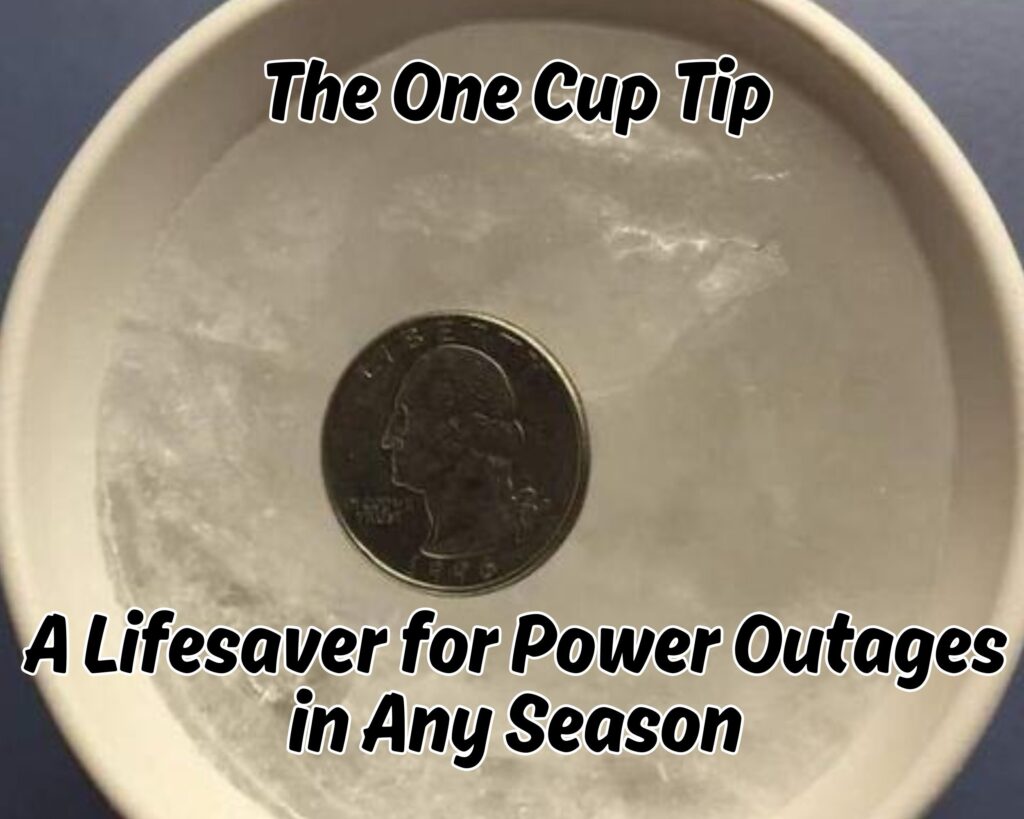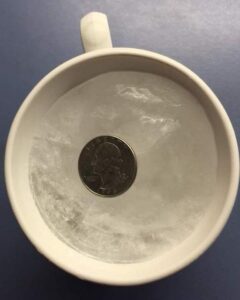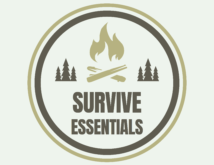In the quiet calm of my kitchen, amidst the hum of the refrigerator and the tick of the clock, lies a simple yet ingenious tool – a frozen cup of water with a quarter on top. This unassuming setup, known as the One Cup Tip, is my go-to method for ensuring food safety during power outages, be it during the fierce winds of hurricane season or the unexpected blackouts of a harsh winter.

The Origin of the One Cup Tip: A Tale of Practical Wisdom
The story of the One Cup Tip began not in a laboratory or a cooking show, but in the shared experiences of everyday people. It’s a trick passed down in communities, a nugget of wisdom that found its way into my life through a neighbor’s advice. It’s a testament to the power of shared knowledge and the ingenuity of ordinary folks in solving everyday problems.
The Simple Science Behind This Effective Trick
The beauty of the One Cup Tip lies in its simplicity and the basic science that powers it. Here’s how it works:
- Freeze a Cup of Water: Fill a cup with water and place it in the freezer. Once it’s frozen solid, you’re set for the next step.
- Place a Quarter on Top: Gently lay a quarter on the frozen surface. This coin now acts as your sentinel, guarding the safety of your frozen goods.
This method is a foolproof indicator of whether your food has stayed frozen during a power outage. When the electricity fails, especially during severe weather conditions or winter storms, the ice in the cup begins to melt, and the quarter starts its descent.
Interpreting the Quarter: A Guide to Food Safety
Upon returning home after an evacuation or simply after a power outage, the position of the quarter in the cup serves as a clear indicator:
- Quarter on Top or Middle: If the quarter is still perched atop or in the middle of the cup, it’s a good sign. Your food likely remained frozen, or the power outage was brief enough not to cause significant thawing.
- Quarter at the Bottom: If the quarter has sunk to the bottom, it’s a red flag. This indicates that the contents of your freezer thawed completely and then refroze, putting your food at risk of spoilage.
Why This Tip is Essential: The Unseen Dangers of Refrozen Food
The danger of refrozen food lies in its deceptive appearance. Food that has thawed and refrozen can look perfectly normal, but harmful bacteria might have multiplied during the thawing period. Consuming such food can lead to foodborne illnesses, a risk that’s easily avoidable with the One Cup Tip.
Keeping the One Cup Tip Year-Round
I’ve made it a practice to keep this setup in my freezer at all times. It’s not just a seasonal precaution; power outages can happen any time of the year. Whether it’s a summer storm, a winter blizzard, or just an unexpected blackout, the One Cup Tip is a reliable way to gauge the safety of your frozen food.
A Simple Solution for a Complex Problem
In a world where we’re often overwhelmed with complex gadgets and technologies, the One Cup Tip stands out for its simplicity and effectiveness. It’s a low-tech solution to a potentially high-stakes problem, ensuring that in times of uncertainty, at least one thing remains certain – the safety of our food.

The One Cup Tip, a simple yet effective method for ensuring food safety during power outages, I discovered additional resources on Survive Essentials that delve deeper into emergency preparedness and survival strategies. These articles not only complement the One Cup Tip but also provide a broader perspective on preparing for and dealing with power outages and other emergency situations.
Staying Prepared for Winter Weather Power Outages
Power outages in winter can be particularly challenging, and being prepared is crucial. The article “Staying Prepared for Winter Weather Power Outages” on Survive Essentials offers valuable insights into how to stay safe and comfortable during winter blackouts. It covers essential tips on maintaining warmth, ensuring a supply of potable water, and keeping communication lines open. This resource is a must-read for anyone looking to enhance their winter preparedness plan.
Welcoming the Wilderness Inside: Embracing Nature in Your Decor
While not directly related to power outages, the article “Welcoming the Wilderness Inside: The Charm of Outdoor-Themed Indoor Decor” provides an interesting perspective on bringing the essence of nature into your home. For those who love the outdoors, this article offers creative ideas for incorporating elements of the wilderness into your living space, creating a soothing and natural environment that can be especially comforting in times of stress, such as during a power outage.
The Culinary Secret for Survivalists
Food safety and preparation are crucial in any emergency situation. The article “The Culinary Secret for Survivalists: Why Anchovy Paste Should Be in Every Prepper’s Pantry” on Survive Essentials explores an often-overlooked aspect of emergency food supplies. It discusses the benefits of having versatile and long-lasting ingredients like anchovy paste in your pantry, which can add flavor and nutrition to your meals, even in challenging situations.
Comprehensive Preparedness with Survive Essentials
The One Cup Tip is just the beginning of a journey into understanding and preparing for various emergency scenarios. By exploring resources like those found on Survive Essentials, you can gain a more comprehensive understanding of how to effectively prepare for and respond to power outages and other emergencies. Whether it’s through practical tips for winter weather preparedness, embracing the calming influence of nature in your home, or discovering versatile food items for your emergency pantry, these resources provide invaluable guidance for anyone looking to enhance their survival skills and knowledge.
Questions and Answers on the One Cup Tip…
What is the One Cup Tip and how does it work?
The One Cup Tip is a simple yet effective method to check if food in your freezer remained frozen during a power outage. You freeze a cup of water, then place a quarter on top of the ice. If the power goes out and the ice melts, the quarter will sink. Upon your return, the position of the quarter indicates whether the food stayed frozen or not. If the quarter is at the bottom, it means the food defrosted and may be unsafe to eat.
Why is the One Cup Tip important?
This tip is crucial for food safety. During power outages, especially in extreme weather conditions, food in the freezer can thaw and spoil without your knowledge. The One Cup Tip is a quick and reliable way to determine if the food might have gone bad, helping you avoid the risk of foodborne illnesses.
Can the One Cup Tip be used in any freezer?
Yes, the One Cup Tip is versatile and can be used in any standard home freezer. It’s a universal method that doesn’t require any special equipment or conditions, making it accessible for everyone.
How long does it take for the quarter to sink to the bottom of the cup during a power outage?
The time it takes for the quarter to sink depends on the temperature inside the freezer and the duration of the power outage. In a prolonged outage, the ice will melt faster, causing the quarter to sink to the bottom of the cup more quickly.
What should I do if I find the quarter at the bottom of the cup?
If the quarter is at the bottom of the cup, it’s best to err on the side of caution and discard the food in the freezer. This position indicates that the food has completely thawed at some point, which could lead to bacterial growth and potential foodborne illness.
Is the One Cup Tip reliable in all situations?
While the One Cup Tip is a good indicator, it’s not foolproof. It should be used as a general guide. If you have any doubts about the safety of your food, it’s safer to throw it out. Remember, “When in doubt, throw it out.”
Can this method be used during short power outages?
Yes, the One Cup Tip is effective even during short power outages. If the quarter has only moved slightly or not at all, it indicates that the food remained largely frozen and is likely safe.
Are there any other similar methods to the One Cup Tip?
While the One Cup Tip is unique in its simplicity, other methods like using a digital thermometer to check the temperature of your freezer contents can also be effective. However, these methods require more effort and may not be as straightforward as the One Cup Tip.
How often should I check the One Cup in my freezer?
It’s a good practice to check the One Cup Tip regularly, especially after returning from an evacuation or if you suspect there has been a power outage. Keeping it in your freezer at all times ensures you’re always prepared to quickly assess the safety of your frozen food.
As an Amazon Associate we earn from qualifying purchases through some links in our articles.




